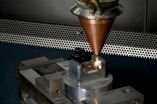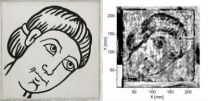(Press-News.org) Forging dies must withstand a lot. They must be hard so that their surface does not get too worn out and is able to last through great changes in temperature and handle the impactful blows of the forge. However, the harder a material is, the more brittle it becomes - and forging dies are less able to handle the stress from the impact. For this reason, the manufacturers had to find a compromise between hardness and strength. One of the possibilities is to surround a semi-hard, strong material with a hard layer. The problem is that the layer rests on the softer material and can be indented by blows, like the shell of an egg.
Researchers from the Fraunhofer Institute for Production Technology IPT in Aachen, Germany have now developed an alternative. "The forging dies we have been working on have a useful life that is up to twice as long," explains Kristian Arntz, head of department at the IPT. "We are using a working material that is less hard and able to handle the impact stress well. We melt the uppermost layer of the material with a laser and introduce a powder into the melt material that is used to chemically alter the characteristics of the material. We have therefore achieved a large degree of hardness in the upper millimeter." The advantage is that since the characteristics of the outer layer do not change abruptly (as is the case in a deposited layer), but increases in hardness gradually (this is also called a hardness gradient) we can circumvent the "egg shell effect". In addition, the particles act like sand paper and prevent the material from wearing off the die. Since the wear only occurs in certain spots of the die, the scientists are very targetedly altering only these surface areas. They are therefore further minimizing the effect the layer has on the impact resistance. Simulations help to calculate the areas that are particularly stressed – and knowledge gained by experience is also applied.
To be able to work on the forging dies, the scientists and their colleagues at Alzmetall have developed a machine with which they are able to work on the free-form die inserts and forging dies. The scientists have also developed a software with ModuleWorks that ensures that the laser travels across the surface at a constant speed and that the gaps between the laser paths remain even – otherwise tears would develop in the surface. "This isn't a problem if the surfaces are straight; however, we had to develop special algorithms for free-formed tools that keep the path distance and the speed constant – even with complex geometries," said Arntz. The machine and the software are ready; the scientists have already manufactured initial tools and dies for the industry. They will introduce the technology at the Euromold trade fair (Hall 11, Booth C66) from November 27 - 30 in Frankfurt, Germany.
The scientists are planning, in a further step, to reduce expensive raw materials such as chromium, molybdenum and vanadium. To date, these materials are present in all forging dies. "We want to utilize the basic fundamentals of our technology so that we only have to alloy the reworked surface layer with these materials."
INFORMATION:
Better protection for forging dies
2012-11-21
ELSE PRESS RELEASES FROM THIS DATE:
CDC and NIH survey provides first report of state-level COPD prevalence
2012-11-21
The age-adjusted prevalence of chronic obstructive pulmonary disease (COPD) varies considerably within the United States, from less than 4 percent of the population in Washington and Minnesota to more than 9 percent in Alabama and Kentucky. These state-level rates are among the COPD data available for the first time as part of the newly released 2011 Behavioral Risk Factor Surveillance System (BRFSS) survey.
"COPD is a tremendous public health burden and a leading cause of death. It is a health condition that needs to be urgently addressed, particularly on a local level," ...
Detective work using terahertz radiation
2012-11-21
It was a special moment for Michael Panzner of the Fraunhofer Institute for Material and Beam Technology IWS in Dresden, Germany and his partners: in the Dresden Hygiene Museum the scientists were examining a wall picture by Gerhard Richter that had been believed lost long ago. Shortly before leaving the German Democratic Republic the artist had left it behind as a journeyman's project. Then, in the 1960s, it was unceremoniously painted over. However, instead of being interested in the picture, Panzer was far more interested in the new detector which was being used for ...
Architecture of rod sensory cilium disrupted by mutation
2012-11-21
HOUSTON – (Nov. 22, 2012) – Using a new technique called cryo-electron tomography, two research teams at Baylor College of Medicine (www.bcm.edu) have created a three-dimensional map that gives a better understanding of how the architecture of the rod sensory cilium (part of one type of photoreceptor in the eye) is changed by genetic mutation and how that affects its ability to transport proteins as part of the light-sensing process.
Almost all mammalian cells have cilia. Some are motile and some are not. They play a central role in cellular operations, and when they ...
New evidence of dinosaurs' role in the evolution of bird flight
2012-11-21
Academics at the Universities of Bristol, Yale and Calgary have shown that prehistoric birds had a much more primitive version of the wings we see today, with rigid layers of feathers acting as simple airfoils for gliding.
Close examination of the earliest theropod dinosaurs suggests that feathers were initially developed for insulation, arranged in multiple layers to preserve heat, before their shape evolved for display and camouflage.
As evolution changed the configuration of the feathers, their important role in the aerodynamics and mechanics of flight became more ...
New Informatics and Bioimaging Center combines resources, expertise from UMD, UMB
2012-11-21
ADELPHI, Md. – A new center that combines advanced computing resources at the University of Maryland, College Park (UMD) with clinical data and biomedical expertise at the University of Maryland, Baltimore (UMB) could soon revolutionize the efficiency and effectiveness of health care in the state of Maryland and beyond.
The Center for Health-related Informatics and Bioimaging (CHIB) announced today joins computer scientists, life scientists, engineers, physicists, biostatisticians and others at the College Park campus with imaging specialists, physicians, clinicians ...
Wormholes from centuries-old art prints reveal the history of the 'worms'
2012-11-21
By examining art printed from woodblocks spanning five centuries, Blair Hedges, a professor of biology at Penn State University, has identified the species responsible for making the ever-present wormholes in European printed art since the Renaissance. The hole-makers, two species of wood-boring beetles, are widely distributed today, but the "wormhole record," as Hedges calls it, reveals a different pattern in the past, where the two species met along a zone across central Europe like a battle line of two armies. The research, which is the first of its kind to use printed ...
Human obedience: The myth of blind conformity
2012-11-21
In the 1960s and 1970s, classic social psychological studies were conducted that provided evidence that even normal, decent people can engage in acts of extreme cruelty when instructed to do so by others. However, in an essay published November 20 in the open access journal PLOS Biology, Professors Alex Haslam and Stephen Reicher revisit these studies' conclusions and explain how awful acts involve not just obedience, but enthusiasm too—challenging the long-held belief that human beings are 'programmed' for conformity.
This belief can be traced back to two landmark empirical ...
Beneficial microbes are 'selected and nurtured' in the human gut
2012-11-21
Animals, including humans, actively select the gut microbes that are the best partners and nurture them with nutritious secretions, suggests a new study led by Oxford University, and published November 20 in the open-access journal PLOS Biology.
The Oxford team created an evolutionary computer model of interactions between gut microbes and the lining (the host epithelial cell layer) of the animal gut. The model shows that beneficial microbes that are slow-growing are rapidly lost, and need to be helped by host secretions, such as specific nutrients, that favour the beneficial ...
The evolution of human intellect: Human-specific regulation of neuronal genes
2012-11-21
A new study published November 20 in the open-access journal PLOS Biology has identified hundreds of small regions of the genome that appear to be uniquely regulated in human neurons. These regulatory differences distinguish us from other primates, including monkeys and apes, and as neurons are at the core of our unique cognitive abilities, these features may ultimately hold the key to our intellectual prowess (and also to our potential vulnerability to a wide range of 'human-specific' diseases from autism to Alzheimer's).
Exploring which features in the genome separate ...
Study finds link between access to online health information and use of clinical services
2012-11-21
DENVER, Nov. 20 — Patients with online access to their medical record, including secure email communication with clinicians, had an associated increase in use of some clinical services, according to new Kaiser Permanente research published this month in the Journal of the American Medical Association.
The study examined health records of more than 500,000 Kaiser Permanente members in Colorado between May 2005 and June 2010. The researchers looked at office visits, telephone encounters, after-hours clinic visits, emergency department encounters, and hospitalizations ...


